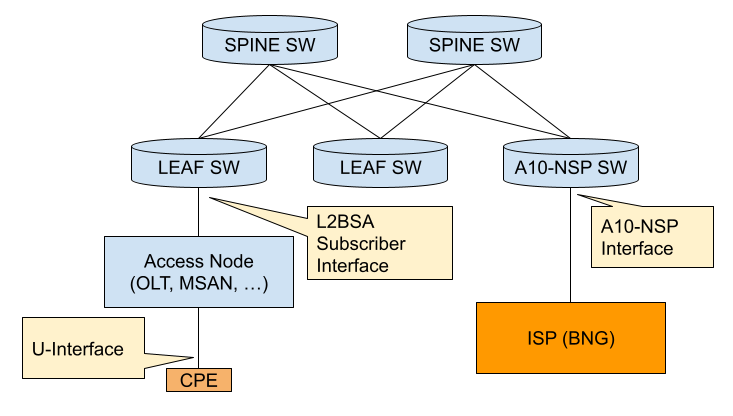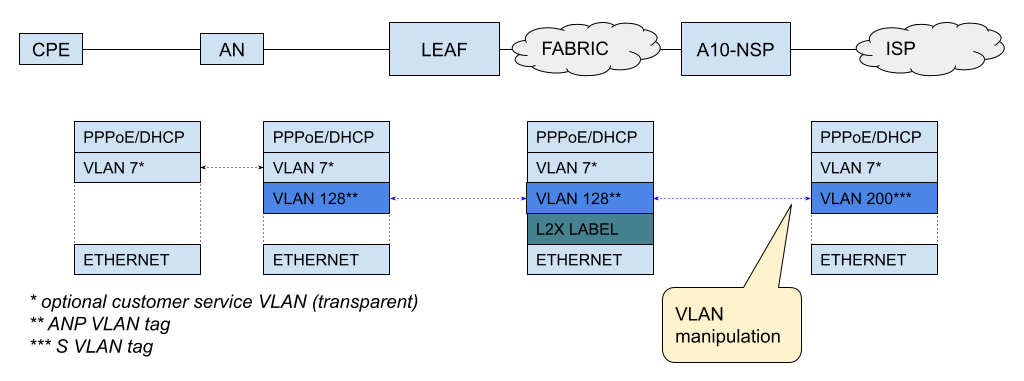Introduction
Layer 2 Bitstream Access (L2BSA) refers to a scenario in which a service provider makes his access infrastructure available to other service providers. These are retail service providers who provide their Internet services. In Germany, this service is mandated by the Federal Network Agency (German: Bundesnetzagentur or BNetzA) which is the regulatory office for electricity, gas, telecommunications, post, and railway markets. It is a federal agency of the Federal Ministry for Economic Affairs and Energy and is headquartered in Bonn, Germany.
The definition of the L2BSA service was defined by the so-called NGA Forum, an advisory board founded in May 2010 by the Bundesnetzagentur for promoting dialogue between the Bundesnetzagentur, network operators, manufacturers, states and local authorities on NGA rollout.
The L2BSA specification defines two interfaces, the so-called U interface (User Interface) at the customer location and the A10-NSP interface (A10 Network Service Provider) between the service provider networks. Those interface types were originally introduced in the Broadband Forum TR-101 (Migration to Ethernet-based Broadband Aggregation).

The U interface is defined as a transparent Layer 2 interface which can be used with or without VLAN tags by the wholesale service providers. This means that some CPE will send their traffic untagged while another CPE is configured for tagged traffic which needs to be transparently forwarded between the U interface and the A10-NSP interface.
The A10-NSP interface is defined as a link aggregation bundle interface with one or more interfaces and LACP enabled or disabled. All traffic on this interface is at least single-tagged with the so-called S-VLAN tag which identifies the U interface. This limits the amount of L2BSA services to 4094 per A10-NSP interface caused by the usable VLAN range. Therefore some providers need multiple A10-NSP interfaces if they need to address more than the 4094 services.
The term A10 relates to the end-to-end ADSL network reference model depicted in the figure below. The Core Network reference model is a subset of the end-to-end architecture; it is composed of two functional blocks and three reference points. The Access Node and the Regional Broadband Network are the two functional blocks. U, V and A10 are the three reference points.

The mapping between the U interface and A10-NSP/S-VLAN is managed by the L2BSA service provider and typically changes frequently triggered by re-provisioning actions. Therefore all PPPoE discovery, as well as DHCPv4/v6 packets, must be enriched with additional line identification headers (Agent-Remote-Id, Agent-Circuit-Id, Actual-Data-Rate, …) by the L2BSA service provider in the upstream direction (from U to A10-NSP interface) to allow the wholesale provider to identify the actual U interface for traffic received on the A10-NSP interface. This functionality is referred to as the intermediate agent functionality.
The U interface is terminated on the access node which might be an OLT for fiber-based access or MSAN for xDSL, therefore the U interface can also be called the customer access line or port. The access node will add additional VLAN for each access line to uniquely identify them between the access node and leaf switch. This VLAN is called the ANP tag (Access-Node-Port).

For L2BSA services all traffic received with a given ANP tag will be transparently forwarded to the corresponding A10-NSP interface via Layer 2 cross-connect (L2X) services. We introduce a new subscriber type for L2BSA in our RBFS access infrastructure to manage those services on the leaf switches and to allow further advanced access services like QoS or subscriber accounting.

L2BSA Services and Subscribers
RBFS distinguishes between L2BSA services and subscribers. L2BSA services are created using the Operational State API (/l2bsa) stored as ephemeral objects in the configuration daemon. Those objects are excluded from the actual
configuration and not restored after reboot. The L2BSA service represents a defined interface to add, update and
delete L2BSA services. Those services are managed by external orchestrators or service managers and are not changed or
deleted by RBFS.
Adding such an L2BSA service triggers the creation of a corresponding L2BSA subscriber which represents the internal state. Each L2BSA subscriber is a full-access subscriber and therefore most subscriber features will work for L2BSA as well. This includes features like RADIUS authentication, accounting, CoA or dynamic QoS. Each L2BSA subscriber persists as long as the service is still present and also if the subscriber has already been terminated. This allows external applications to collect all states and counters before the subscriber is finally deleted triggered by L2BSA service delete.